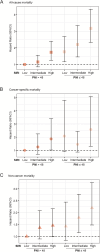Combined association of systemic inflammatory response index and prognostic nutritional index with survival among US cancer survivors
- PMID: 40597939
- PMCID: PMC12210657
- DOI: 10.1186/s12885-025-14509-x
Combined association of systemic inflammatory response index and prognostic nutritional index with survival among US cancer survivors
Abstract
Background: Systemic inflammation and nutritional status play critical roles in determining clinical outcomes across multiple disease entities, particularly malignancies. Significantly, these two pathophysiological factors exhibit dynamic interplay through shared pathobiological mechanisms. This study sought to investigate the independent and combined prognostic capacity of the systemic inflammatory response index (SIRI) and prognostic nutritional index (PNI) in predicting all-cause, cancer-specific, and non-cancer mortality among cancer survivors.
Methods: Utilizing the National Health and Nutrition Examination Survey (NHANES) data from 2005 to 2018, 3,289 adult cancer survivors (weighted population: 20,795,493) were analyzed. Restricted cubic splines (RCS) delineated mortality risk nonlinearity. Survival trajectories were assessed via Kaplan-Meier (KM) analysis with complex survey adjustments. Weighted Cox proportional hazards models quantified independent and joint associations.
Results: Eight hundred seventy-four deaths were identified over a median follow-up of 6.5 years. By RCS analyses, SIRI exhibited a linear association with all-cause mortality, whereas PNI demonstrated a nonlinear relationship with all-cause mortality. Weighted Cox regression analysis demonstrated increased all-cause, cancer-specific, and non-cancer mortality risks in cancer survivors with high-SIRI or with undernutrition (PNI ≤ 48). Joint analysis showed that cancer survivors with concurrent high-SIRI and undernutrition had the highest risk for all-cause (HR 3.169, 95%CI 2.324-4.321), cancer-specific (HR 2.578, 95%CI 1.308-5.080) and non-cancer (HR 2.197, 95%CI 1.480-3.261) mortality, respectively, relative to the reference group with concurrent low-SIRI and PNI > 48. Subgroup and interaction analysis confirmed the stability of the core results.
Conclusion: SIRI and PNI emerged as independent prognostic predictors with synergistic mortality prediction capacity in cancer survivors. Cancer survivors with concurrent high level of systemic inflammation and poor nutritional status was associated with the highest mortality risk for all-cause, cancer-specific, and non-cancer.
Keywords: Cancer survivors; NHANES; Prognostic nutritional index; Systemic inflammatory response index.
© 2025. The Author(s).
Conflict of interest statement
Declarations. Ethics approval and consent to participate: The protocols of NHANES were approved by the institutional review board of the National Center for Health Statistics, CDC ( https://www.cdc.gov/nchs/nhanes/irba98.htm ). All participants provided written consent after being fully informed. Consent for publication: Not applicable. Competing interests: The authors declare no competing interests.
Figures






Similar articles
-
Impact of systemic immune inflammation index and systemic inflammation response index on all-cause and cardiovascular mortality in cardiovascular-kidney-metabolic syndrome.Eur J Med Res. 2025 Jul 21;30(1):645. doi: 10.1186/s40001-025-02929-1. Eur J Med Res. 2025. PMID: 40685352 Free PMC article.
-
Relationship of prognostic nutritional index with anemia and all-cause mortality: a NHANES study.Hematology. 2025 Dec;30(1):2536402. doi: 10.1080/16078454.2025.2536402. Epub 2025 Jul 22. Hematology. 2025. PMID: 40694684
-
Association between alkaline phosphatase and cancer in American adults: 2003-2016 NHANES.BMC Cancer. 2025 Jul 9;25(1):1157. doi: 10.1186/s12885-025-14533-x. BMC Cancer. 2025. PMID: 40634930 Free PMC article.
-
Nutritional interventions for survivors of childhood cancer.Cochrane Database Syst Rev. 2016 Aug 22;2016(8):CD009678. doi: 10.1002/14651858.CD009678.pub2. Cochrane Database Syst Rev. 2016. PMID: 27545902 Free PMC article.
-
Impact of residual disease as a prognostic factor for survival in women with advanced epithelial ovarian cancer after primary surgery.Cochrane Database Syst Rev. 2022 Sep 26;9(9):CD015048. doi: 10.1002/14651858.CD015048.pub2. Cochrane Database Syst Rev. 2022. PMID: 36161421 Free PMC article.
Cited by
-
Predictive Value of the Cally Score in Determining Surgical Strategy for Complicated Left-Sided Colonic Diverticulitis: A Retrospective Cohort Study.Medicina (Kaunas). 2025 Aug 13;61(8):1455. doi: 10.3390/medicina61081455. Medicina (Kaunas). 2025. PMID: 40870500 Free PMC article.
References
-
- Bray F, Laversanne M, Sung H, Ferlay J, Siegel RL, Soerjomataram I, Jemal A. Global cancer statistics 2022: GLOBOCAN estimates of incidence and mortality worldwide for 36 cancers in 185 countries. CA Cancer J Clin. 2024;74(3):229–63. - PubMed
-
- Diakos CI, Charles KA, McMillan DC, Clarke SJ. Cancer-related inflammation and treatment effectiveness. Lancet Oncol. 2014;15(11):e493–503. - PubMed
-
- Mantovani A, Allavena P, Sica A, Balkwill F. Cancer-related inflammation. Nature. 2008;454(7203):436–44. - PubMed
-
- Alexandre J, Gross-Goupil M, Falissard B, Nguyen ML, Gornet JM, Misset JL, Goldwasser F. Evaluation of the nutritional and inflammatory status in cancer patients for the risk assessment of severe haematological toxicity following chemotherapy. Ann Oncol. 2003;14(1):36–41. - PubMed
MeSH terms
LinkOut - more resources
Full Text Sources
Medical

